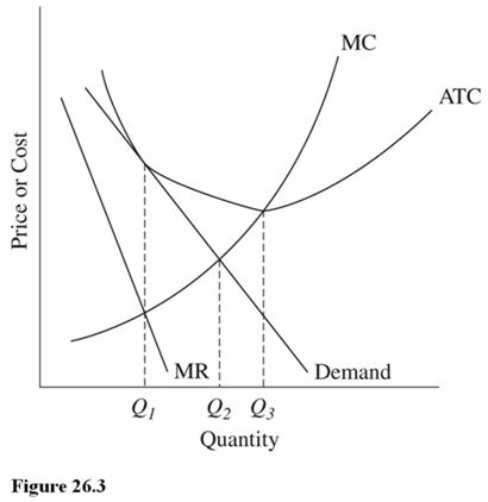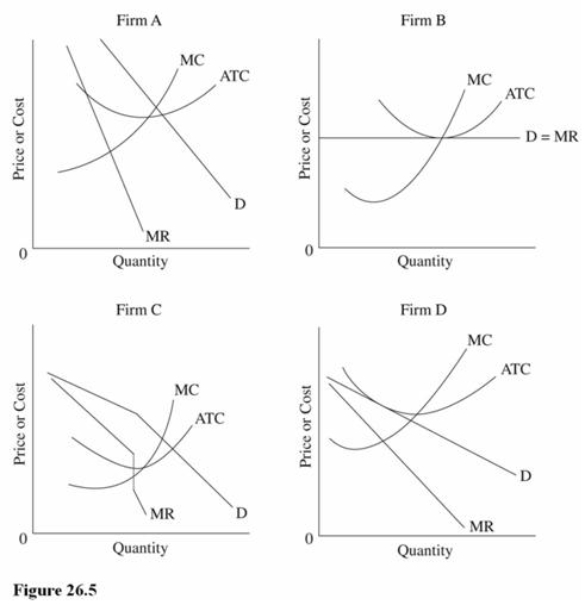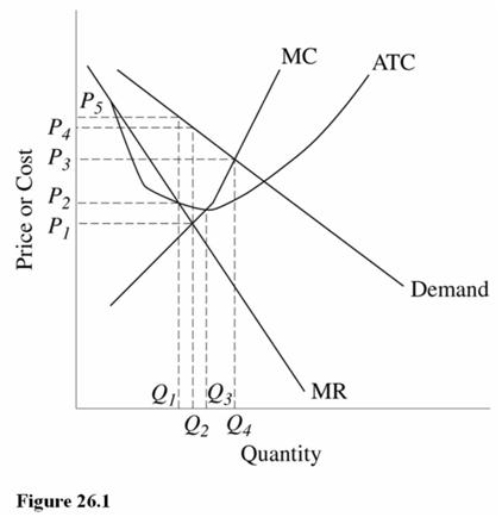A) Has no market power.
B) Captures significant economies of scale.
C) Has a downward-sloping demand curve.
D) Has a standardized product that all firms produce.
Correct Answer

verified
Correct Answer
verified
Multiple Choice
One of the reasons for low cross-price elasticity in monopolistic competition and high cross-price elasticity in perfect competition is that
A) Firms in perfect competition differentiate their products.
B) In monopolistic competition brand loyal consumers view other available products as poor substitutes.
C) Consumers do not have perfect substitutes in perfect competition.
D) To save money, firms in monopolistic competition do not advertise.
Correct Answer

verified
Correct Answer
verified
Multiple Choice
Which of the following characterizes the difference between oligopoly and monopolistic competition?
A) Oligopolists are independent of each other; monopolistically competitive firms are interdependent.
B) Monopolistically competitive firms experience zero long-run economic profit; oligopolists may experience positive long-run economic profit.
C) There are many oligopolists but only a few monopolistically competitive firms.
D) Monopolistically competitive firms face horizontal demand curves; oligopolists face downward-sloping demand curves.
Correct Answer

verified
Correct Answer
verified
Multiple Choice
Which of the following market structures will have higher prices in the long run than perfect competition, ceteris paribus?
A) Monopolistic competition and monopoly, but not oligopoly.
B) Oligopoly and monopoly, but not monopolistic competition.
C) Monopoly, but not oligopoly or monopolistic competition.
D) Monopolistic competition, monopoly, and oligopoly.
Correct Answer

verified
Correct Answer
verified
Multiple Choice
 Refer to Figure 26.3 for a monopolistically competitive firm in the long run.Which of the following observations results in the problem of excess capacity?
Refer to Figure 26.3 for a monopolistically competitive firm in the long run.Which of the following observations results in the problem of excess capacity?
A) The firm is producing less than the minimum-ATC output rate.
B) The firm is producing at Q3 instead of where MR = MC.
C) The firm is earning only zero economic profits in the long run.
Correct Answer

verified
Correct Answer
verified
Multiple Choice
In monopolistic competition, a firm's demand curve is tangent to the ATC curve in the long run because
A) Barriers to entry are high.
B) Entry eliminates economic profit, and exit eliminates losses.
C) Advertising is ineffective in differentiating the product.
D) Producers are price takers.
Correct Answer

verified
Correct Answer
verified
True/False
Marginal cost pricing means that goods are offered for sale at prices equal to their marginal cost.
Correct Answer

verified
Correct Answer
verified
True/False
The monopoly aspect of monopolistic competition is that there is only one seller.
Correct Answer

verified
Correct Answer
verified
Multiple Choice
Demand and Cost Data for Will's Beach Ball Company
| Price | Demand Data Quantity | Cost Data Output | Total Cost |
|---|---|---|---|
| $11 | 6 | 6 | $48 |
| $10 | 7 | 7 | $52 |
| $9 | 8 | 8 | $57 |
| $8 | 9 | 9 | $63 |
| $7 | 10 | 10 | $70 |
A) 6 beach balls; $11
B) 7 beach balls; $10
C) 8 beach balls; $9
D) 9 beach balls; $8
Correct Answer

verified
Correct Answer
verified
True/False
Monopolistic competition results in allocative efficiency.
Correct Answer

verified
Correct Answer
verified
Multiple Choice
All of the following are examples of nonprice competition except
A) Better service.
B) Advertising.
C) Improved quality.
D) Zero economic profit.
Correct Answer

verified
Correct Answer
verified
Multiple Choice
Demand and Cost Data for Will's Beach Ball Company
| Price | Demand Data Quantity | Cost Data Output | Total Cost |
|---|---|---|---|
| $11 | 6 | 6 | $48 |
| $10 | 7 | 7 | $52 |
| $9 | 8 | 8 | $57 |
| $8 | 9 | 9 | $63 |
| $7 | 10 | 10 | $70 |
A) $36.
B) $30.
C) $140.
D) $144.
Correct Answer

verified
Correct Answer
verified
Multiple Choice
One In the News article is titled "The Cola Wars: It's Not All Taste." Firms in a monopolistically competitive industry, such as the soft drink market, are likely to advertise in an attempt to
A) Allocate resources more efficiently.
B) Decrease the price elasticity of demand.
C) Reduce market power.
D) Increase the cross-price elasticity of demand
Correct Answer

verified
Correct Answer
verified
Multiple Choice
Firms in a monopolistically competitive market will
A) Produce efficiently.
B) Make economic profits in the long run.
C) Use the profit-maximizing rule MC = MR.
D) Produce at the minimum of ATC.
Correct Answer

verified
Correct Answer
verified
Multiple Choice
Which of the following industries is not an example of monopolistic competition?
A) Pizza delivery.
B) Toys.
C) Notebook computers.
D) Airlines.
Correct Answer

verified
Correct Answer
verified
True/False
A monopolistically competitive firm maximizes profits in the short run and long run at an output level where marginal revenue equals marginal costs.
Correct Answer

verified
Correct Answer
verified
Multiple Choice
 Refer to Figure 26.5.Which firm is least likely to engage in advertising?
Refer to Figure 26.5.Which firm is least likely to engage in advertising?
A) Firm A only.
B) Firm B only.
C) Firm C only.
D) Firms A, C, andD.
Correct Answer

verified
Correct Answer
verified
True/False
A monopolistically competitive firm confronts a downward-sloping demand curve and as a result has some market power.
Correct Answer

verified
Correct Answer
verified
Multiple Choice
If new firms enter a monopolistically competitive market, the demand curves for the existing firms will shift to the
A) Left and become more price-inelastic.
B) Left, and there will be no change in price elasticity.
C) Left and become more price-elastic.
D) Right, and there will be no change in price elasticity.
Correct Answer

verified
Correct Answer
verified
Multiple Choice
 Refer to Figure 26.1.The output that maximizes production efficiency for this firm is
Refer to Figure 26.1.The output that maximizes production efficiency for this firm is
A) Q1.
B) Q2.
C) Q3.
D) Q4.
Correct Answer

verified
Correct Answer
verified
Showing 61 - 80 of 150
Related Exams